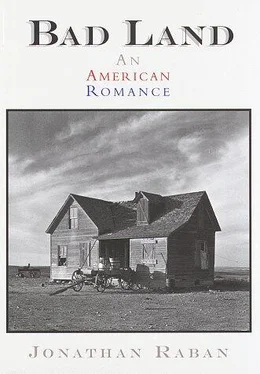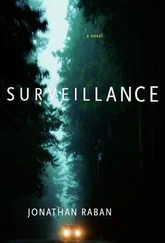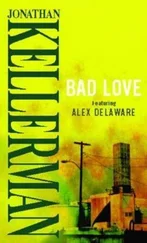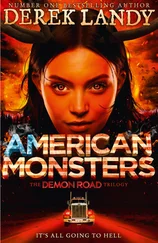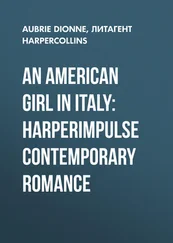Here the canals — the Floweree, the Greenfield Main — were dry until the spring, their beds a piebald and unlovely mixture of dried mud and white ice. Nor could the local architecture bear the Dutch comparison. The old WPA standard-issue farmhouses were still here, incorporated, as kitchens, or rec rooms, into rambling bungaloid assemblages of add-ons and afterthoughts. Instead of the spires and campaniles of the Dutch churches, one had to make do with the whitewashed garages of the Assembly of God and the Church of Christ, whose theology, at least, was equal to the fiercest brands of Dutch Protestantism.
God made the world, Man made Holland, and F. D. Roosevelt made the Fairfield Bench. After nearly sixty years, it still had the plain, angular, utility stamp of the New Deal on it. It looked like a government project. The town of Fairfield (“The Malt Barley Capital Of The USA”) could be seen from far off as a line of silver storage tanks, in whose shadow lay fifty or so more-or-less-identical single-story frame houses; tidy, white, decently maintained, irreproachably dull.
Two-point-five miles up a long, straight, dirt road, I found the Dale Paddock mailbox. It stood outside a farm like all the other farms on the Fairfield Bench.
Dale Paddock had been eight when the family moved here from Ismay. He opened the back door as I drove into the farmyard: a lopsided smile, a shock of gray hair, combed back fifties-style, the look of an aging James Cagney, and the soft voice of someone trying not to disturb a sleeper in the next room.
I had in my bag a stack of photographs of the Wollaston place. He hadn’t been back there since 1937. We laid them out on his kitchen table.
“Oh, my!” he said.
There was the slope down which he, his two brothers and his sister used to sled in winter. He remembered it as being a lot higher. Yes, that was where the horse barn was … and the hog house … and there was the path to the chicken run …
“What’s that?” He stopped me as I riffled through a batch of pictures.
I knew what he was going to say.
“That’s my sled! That’s the sled my Dad made!”
“Really?”
I was a little reluctant to let him have the photo: the words “Percy’s Sled” were clearly penciled on the back. Now I had two eight-year-olds in competition for it.
“Oh, my. I never thought I’d see that again …”
He talked of how the family had gotten by in the drought of the 1930s. His father made all the children’s toys, his mother made their clothes. They lived on chickens and home-grown vegetables. The few cents a week that entered the household came from sales of butter, cream and eggs to Leon Clark’s Mildred store. “We never went hungry, but we lived pretty frugal.”
He still lived pretty frugal, in frayed work shirt and patched overalls. His kitchen was bare, and he didn’t offer so much as a glass of water. But he farmed 600 acres of prime barley land, and the yard outside was rich in agricultural machinery.
He remembered the move in oddly bitter terms. The day before the family left, he had packed a barrel with his toys. His father, who was feared by the boy as a grim disciplinarian, had said that there was no room in the boxcar for Dale’s precious barrel.
“Mostly what I remember about the move is those toys.”
A full minute later, he was back on the topic.
“It was only a very small barrel.”
“But when you got to Fairfield, how did you see the difference between the Wollaston place and here? Can you remember how it struck you, as a child?”
He brightened. “Oh, but there was a world of difference — there was water!”
The newcomers learned the happy, arduous craft of irrigation. They dug trenches in their fields, then built dams to block the sluggish current in the supply ditches. The water rose, the long trenches slowly filled. Glittering tinsel threads of water lined each field — a lovely sight to a dry-farmer’s eye.
Big fish lived in the ditches. Fairfield water came from the Sun River Canyon high up in the Rockies. It made its long and circuitous descent via the Pishkun Canal, the Sun River Slope Canal, the Spring Valley Canal and the Greenfield Main Canal. Fat trout swam down from the mountains to the Fairfield Bench, in search of easy pickings. The new farmland was bugrich. Gnats and grasshoppers were constantly tumbling into the ditches, where the water in the evenings was pockmarked with the circles of rising fish. Thrashing two-pounders could be caught with worms and a bamboo pole, tickled (by the canny and the patient) or speared with a pitchfork.
Just weeks before, people had been on their knees, praying for enough rain to darken their fields of dust. At Fairfield, they became hydraulic engineers, spear fishermen, intimates of water, the Montana-Dutch. It must have seemed a miraculous deliverance.
“Did this experience turn you all into staunch Democrats?” I asked. “Did you go on being grateful to the government for its invention? Do you think the government still ought to be active in agriculture?”
“Well,” Dale Paddock said, with caution, “my father was a Democrat. He was all for Roosevelt.”
“And you?”
“I vote for who I think is best. But I’d have to say this: we wouldn’t be sitting here where we are, talking at this table, if it hadn’t been for FDR and his New Deal.”
Eight miles south of Fairview, I picked up the trail of Ned and Dora Wollaston on their way west in 1927. The Rockies were now heaped high along the horizon — razor-edged, matte black, lightly stippled with snow. US 200, climbing steadily toward the Continental Divide at Rogers Pass, snaked through grassy carbuncular foothills dotted with juniper trees.
The Wollastons were on Percy’s trail. In 1924, Percy had left Mildred on the train, his high school diploma safe in his bag on the overhead rack. When he reached Seattle, he’d take a temporary job and try to find himself a college place, maybe at the University of Washington. He got as far as Thompson Falls, Montana. The Clark Fork valley was gray with wood smoke. Passengers on the train were coughing and dabbing at their eyes with handkerchiefs; and when the train pulled into the Clark Fork depot, an official from the Forest Service went from carriage to carriage, calling for able-bodied volunteers to help fight the fire. Hoboes climbed out from under the wheels of the train, and Percy joined the growing band of young men at the side of the track. Three years later, he was still in Thompson Falls. He and Myrtle Amundson were engaged to be married in the summer.
The bends in the road were getting tighter, the incline steepening, the solitary junipers giving way to stands of fir. The Jeep made all this too easy. Even in cars I owned, not too long ago, I would have been down to second gear, with the needle on the temperature gauge dickering near the H -mark. Crossing the Continental Divide in a Model T was a matter of long, slow nursing; watching the dials, feeling one’s way up the dirt road through the narrow tires and hard suspension. I could do a lazy forty-five; Ned and Dora would have been lucky to be doing ten.
At close to 4,000 feet, we at last entered that landscape for which Albert Bierstadt’s painting of the surveyor’s wagon on the plains seemed to be pining from a distance — a landscape of frame, mass, composition. The road corkscrewed round walls of sheer rock, with fir trees clinging by their toes to the barest hint of a ledge. The forest, dusted with snow, fell away into the chasm on the left-hand side of the highway. Dark nimbus clouds rolled overhead, and, through a break between them, the afternoon sun showed in diagonal bars of light. The tires of the Jeep hissed in the sand-stained slush on the pavement.
Читать дальше
